Which of the following is not part of the upper respiratory system?
- Nose
- Oral cavity
- Pharynx
- Trachea
- Nasal meatuses
D
The conducting zone does NOT act to
- Clean air of debris
- Conduct air into the lungs
- Add water to air
- Warm air
- All of the above
E
The nose connects with the pharynx through the
- Septal cartilage
- External nares
- Choanae
- Uvula
- Nasal meatuses
C
Which of the following is a passageway for air, food and water?
- Pharynx
- Larynx
- Paranasal sinuses
- Trachea
- Esophagus
A
The opening to the pharynx from the mouth is called
- Palatine
- Hypopharynx
- Meatuses
- Fauces
- Vestibule
D
This structure prevents food or water from entering the trachea.
- Arytenoid cartilage
- Epiglottis
- Nasopharynx
- Thyroid cartilage
- Paranasal sinus
B
During swallowing, which structure rises?
- Pharynx
- esophagus
- Trachea
- Palatine tonsils
- Primary bronchi
A
These are triangular pieces of mostly hyaline cartilage located at the posterior and superior border of the cricoid cartilage.
- Corniculate cartilage
- Arytenoids cartilage
- Cricotracheal cartilage
- Cuneiform cartilage
- Laryngeal cartilage
B
Pitch is controlled by
- Vibration of the vocal chords
- Tension of the vocal chords
- Layers of cartilage in the vocal chords
- Arrangement of the vocal chords
- None of the above
B
This is located anterior to the esophagus and carries air to the bronchi.
- Trachea
- Larynx
- Nasopharynx
- Pharynx
- None of the above
A
This is the primary gas exchange site.
- Trachea
- Bronchiole
- Nasal sinuses
- Alveolus
- Bronchus
D
Which of the below tissues maintains open airways in the lower respiratory system?
- stratified squamous epithelium with keratin
- ciliated pseudostratified columnar epithelium with goblet cells
- hyaline cartilage
- mucus membrane
- bone
C
Which of the below tissues provides the functions of the inner layer of the conducting organs?
- stratified squamous epithelium with keratin
- ciliated pseudostratified columnar epithelium with goblet cells
- cilated cuboidal epithelium with goblet cells
- transitional epithelium with cilia
- columnar connective tissue with goblet cells
B
The point where the trachea divides into right and left primary bronchi is a ridge called
- Carina
- Secondary bronchioles
- Parietal pleura
- Visceral pleura
- Diaphragm
A
Which of the below tissues forms the exchange surfaces of the alveolus?
- stratified squamous epithelium
- ciliated pseudostratified columnar epithelium with goblet cells
- simple squamous epithelium
- hyaline cartilage
- columnar connective tissue with goblet cells
C
These are cells of the alveoli that produce surfactant.
- Type I alveolar cells
- Type II alveolar cells
- Type III alveolar cells
- Surface cells
- Macrophages
B
This is direction of diffusion of gases at capillaries near systemic cells.
- Oxygen into blood , Carbon dioxide into blood
- Oxygen out of blood , Carbon dioxide into blood
- Oxygen into blood , Carbon dioxide out of blood
- Oxygen out of blood , Carbon dioxide out of blood
B
This is direction of diffusion of gases at the alveoli of the lungs.
- Oxygen into blood , Carbon dioxide into blood
- Oxygen out of blood , Carbon dioxide into blood
- Oxygen into blood , Carbon dioxide out of blood
- Oxygen out of blood , Carbon dioxide out of blood
C
Exhalation begins when
- Inspiratory muscles relax
- Diaphragm contracts
- Blood circulation is the lowest
- Both A and B
- All of the above
A
This means the lungs and the chest wall expand easily.
- High surface tension
- Low surface tension
- High compliance
- Low compliance
- None of the above
C
The conducting airways with the air that does not undergo respiratory exchange are known as the
- Inspiratory volume
- Expiratory reserve volume
- Minimal volume
- Residual volume
- Respiratory dead space
E
This is the sum of the residual and the expiratory reserve volume.
- Total lung capacity
- Functional residual capacity
- Inspiratory capacity
- Vital capacity
- Minimal volume
B
Which of the following is not a factor that the rate of pulmonary and systemic gas exchange depends on.
- Partial pressure difference of the gases
- Surface area for gas exchange
- Diffusion distance
- Molecular weight and solubility of the gases
- Force of contraction of diaphragm
E
Which is the dominant method of carbon dioxide transport?
- Bound to hemoglobin
- Bound to oxygen
- Dissolved in plasma as a gas
- Dissolved in plasma as bicarbonate ions
- Diffusion
D
When blood pH drops then the amount of oxyhemoglobin _______ and oxygen delivery to the tissue cells ________________.
- increases, increases
- increases, decreases
- decreases, increases
- decreases, decreases
- Does not change
C
Which is a factor that does NOT affect hemoglobin’s affinity for oxygen?
- pH of blood
- Partial pressure of the oxygen
- Amount of oxygen available
- Temperature
- Respiratory rate
E
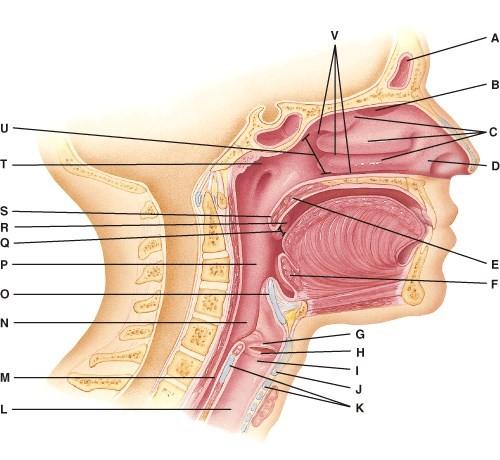
Where are the nasal conchae?
- A
- C
- T
- U
- V
B

This portion of the pharynx has five openings in its wall.
- C
- E
- N
- P
- T
E

Which tonsils are found in the oropharynx?
- V
- R
- S
- Q
- U
B

What is also referred to as the Adam’s Apple?
- G
- H
- I
- J
- K
D

Where is the larynx?
- I
- M
- L
- N
- O
A

This is a ring of hyaline cartilage that forms the inferior wall of the larynx.
- J
- K
- G
- H
- O
B

Where is the uvula?
- E
- F
- Q
- S
- U
D

Where are the palatine tonsils?
- E
- F
- R
- U
- None of the above
C

Where is the soft palate?
- C
- E
- G
- Q
- S
B

Where is the epiglottis?
- O
- R
- S
- F
- Q
A

Where are the olfactory receptors found?
- A
- B
- C
- D
- U
B
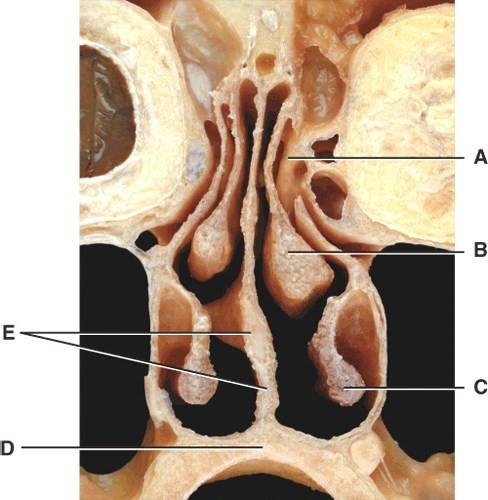
Where is the middle nasal concha?
- A
- B
- C
- D
- E
B

Where is the inferior nasal concha?
- A
- B
- C
- D
- E
C

What is E pointing to?
- Soft palate
- Ethmoid bone
- Hard palate
- Nasal septum
- Air cells
D
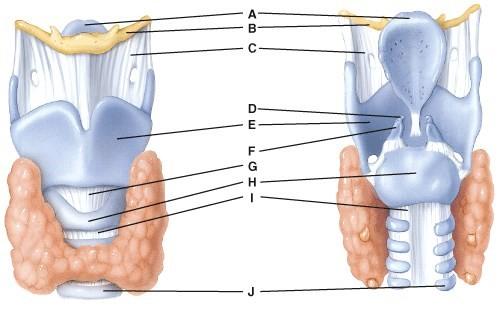
What is line D pointing to?
- Thyrohyoid membrane
- Corniculate cartilage
- Cricothyroid ligament
- Cricoid cartilage
- Tracheal cartilage
B

Where is the cricoid cartilage?
- D
- E
- F
- G
- H
E

Where is the tracheal cartilage?
- J
- I
- H
- G
- F
A

What is line A pointing to?
- Hyoid bone
- Trachea
- Adams Apple
- Thyroid
- Epiglottis
E
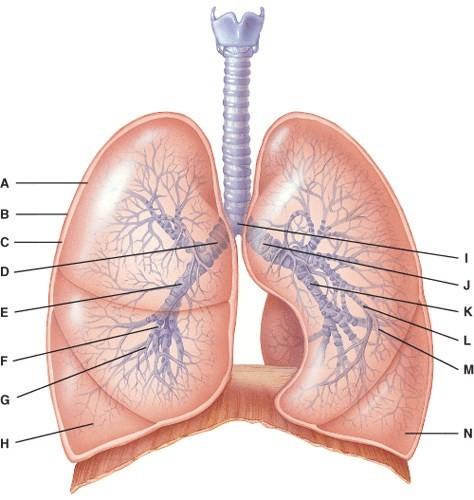
Where is the structure that regulates air flow to the alveolus?
- G
- M
- H
- A
- None of the above
B

What is line J pointing to?
- Right secondary bronchus
- Left secondary bronchus
- Right primary bronchus
- Left primary bronchus
- Carina
D

Where is the right bronchiole?
- F
- G
- H
- L
- M
B

What lines are pointing to tertiary bronchi?
- E and K
- D and J
- F and L
- H and M
- A and B
C

What is line B pointing to?
- Carina
- Visceral pleura
- Parietal pleura
- Pleural cavity
- Diaphragm
C
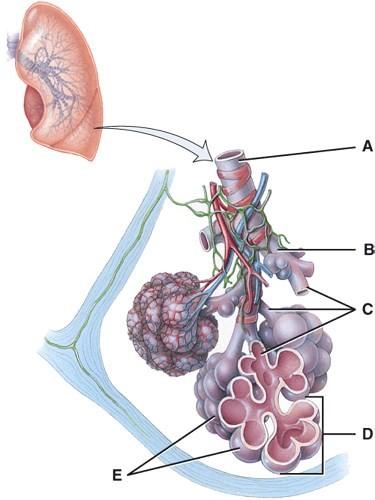
In this portion of the lungs, the epithelial lining is simple squamous.
- A
- B
- C
- D
- E
E

This is the primary gas exchange structure.
- A
- B
- C
- D
- E
E

What is line C pointing to?
- Terminal bronchiole
- Respiratory bronchiole
- Alveolar ducts
- Alveolar sac
- Alveoli
C

Where is the terminal bronchiole?
- A
- B
- C
- D
- E
A
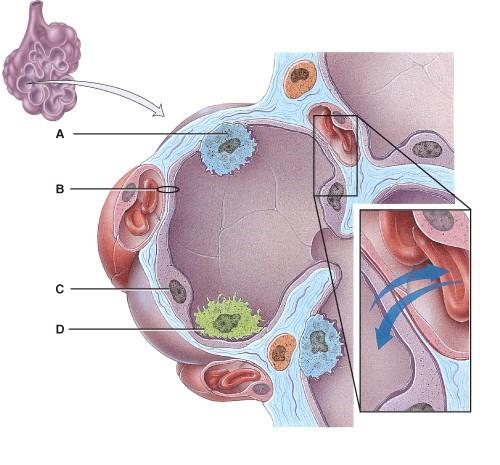
This provides disease resistance within the lungs.
- A
- B
- C
- D
- None of the above
D

Which cells are the main sites of gas exchange?
- A
- B
- C
- D
- All of the above
C

Which cell secretes surfactant?
- A
- B
- C
- D
- None of the above
A